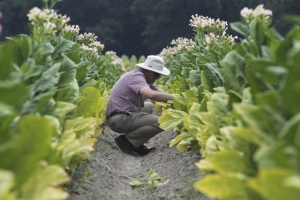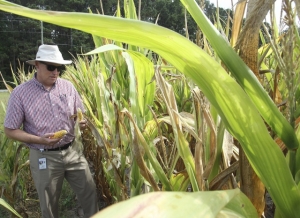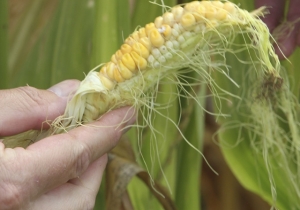Crops suffer from heat, lack of rain
By Steve Herring
Published in News on July 22, 2018 3:05 AM

News-Argus/STEVE HERRING
Wayne County Extension Director Kevin Johnson kneels to check out the lower leaves on tobacco plants in a field just west of Pikeville. The county's corn, tobacco and soybean crops are suffering because of dry conditions and high temperatures.

News-Argus/STEVE HERRING
Wayne County Extension Director Kevin Johnson checks out a field of corn near Pikeville. The county's corn, tobacco and soybean crops are suffering because of dry conditions and high temperatures.

News-Argus/STEVE HERRING
Dry conditions and hot temperatures have left corn in some parts of Wayne County parched and stunted.
Wayne County Extension Director Kevin Johnson pulls a stunted ear of corn off a parched stalk and pulls back the husk to reveal its poor development.
He repeats the task two more times with the same result.
The field is located in northwestern Wayne County -- an area particularly hard hit by drought and heat.
It could be any of the fields of parched corn and stunted soybeans and tobacco that dot the Wayne County countryside -- the victims of too little rain and too much heat.
The farmer will face a tough economic choice of whether to try to harvest anyway or simply bush hog the field, Johnson said.
Johnson expects to see that happen this year -- in some cases, it won't be worth the time and effort to harvest.
It is too early to predict what the economic loss will be to the county's crops because of the lack of rain and weeks of broiling heat, Johnson said.
The rain forecast through at least Tuesday should help tobacco and soybeans rebound somewhat, but it comes too late to salvage the corn crop.
Johnson said he is hoping for a soaking rain of several inches over the next few days.
"It is too late for corn," Johnson said. "Corn has already done what it is going to do. In a lot of cases, it burned up. The late planting of corn burned up.
"The earlier planted corn has already gone through pollination. In some cases where it was so hot, it didn't get any rain. There's not going to be hardly anything there."
There are pockets of better crops scattered around the county that received more timely rains, he said.
That includes the Mount Olive area. Grantham has not been as fortunate, but it is better than the Pikeville, Princeton and Nahunta area, Johnson said.
About 20,000 acres are planted in corn -- down somewhat because of poor crops over the past several years.
Piled on top of that are four years of low commodity prices and the looming litigations against the livestock industry, Johnson said.
"It has kind of put a cloud over agriculture right now," he said. "It has just been a tough time. We had been hoping we would have a good year."
Corn by far is the crop hurt the most, he said.
Normally, the average yield is around 100 bushels per acre, he said. This year, the county average could be between 50 and 75 bushels, Johnson said.
Some fields could end up with no yield at all, he said.
"Think about this, a farmer is going to have about somewhere around $400 an acre in corn," he said. "If he picks 100 and it's at $450, he might break even. Of course if he picks 50, he might get half of his money back.
"If he picks nothing, then he has lost $400 an acre. That is an example of just how much money they can lose."
Since June 1, the weather station at the county airport has recorded 28 days where the temperature topped 90 degrees and 11 days when it was more than 95 degrees, Johnson said.
Corn pollination is limited once the temperature hits 95 degrees, and when it gets up around 98 degrees, it does not pollinate at all, he said.
Starting around around mid-June when the corn started to pollinate, the county experienced an eight-day run of temperatures over 90 degrees, including two days of 98 degrees or more, Johnson said.
Tobacco, still the county's No. 1 cash crop, can better withstand the heat and dry weather, he said.
Parts of the county have experienced extreme dry weather, and in those places, tobacco and soybeans have simply not grown as much as they normally would, he said.
Tobacco is struggling in the same area as the corn, and there is a swath from LaGrange to Seven Springs where tobacco is suffering as well, Johnson said.
"We are definitely going to have some losses with tobacco," he said. "Some of the lower crop has burned up. We still have some tobacco that hasn't been topped (the blooms broken off) because we are sitting there struggling, the leaves are just not filling out.
"The plants are trying to conserve energy so they have cupeled (the leaves) up. But the interesting thing about tobacco is, if we do get some rain, tobacco will be able to compensate."
However, even with that compensation, Johnson expects there will be quality issues with the crop that could result in lower poundage per acre.
That will be even more of a challenge for local growers who have to compete with foreign tobacco, he said.
Approximately 7,700 acres of tobacco were planted, down from about 10,000 acres in prior years.
That is because tobacco companies have been scaling back and global competition, Johnson said.
"Like I said it is like with our other crops, we have areas that had more timely rains, and the scarps look pretty good," Johnson said. "Farmers have started putting in.
"Of course it is the lugs (bottom leaves) they are putting in. It is hard to judge what you crop is going to be like off of lugs."
Soybeans, the county's No. 1 crop in terms of acreage, are off, too, and by a lot this year, Johnson said.
Between 40,000 and 45,000 acres were planted in soybeans compared to an average of around 60,000 acres.
"But a lot of soybeans have not been planted," he said."It has been so dry that they couldn't plant them. There have been cases were soybeans have been planted in the last couple weeks, and they are just sitting there. They haven't come up.
"I have seen soybeans that were planted, and they did come up, but they are just sitting there. They are not growing. The soybeans are really short right now."
If the rain falls as predicted, the crop will compensate, but there still will be losses, he said.
Not being able to plant the soybeans is a lost opportunity, Johnson said.
Cotton is not one of the county's major crops, but still around 6,000 acres were planted this year -- a bit of an increase because of an earlier uptick in prices. The prices have since dropped.
The plants are blooming out of the top, which means it's short, has not had a lot of vegetative growth, and the reproductive growth has come up to the top, Johnson said.
"We have kind of reached a point where its yield potential has stopped," he said. "But it's like soybeans. (If) we get some rain, it will start its vegetative growth, reproductive growth.
"We still have time to make a crop on cotton. All of our crops are struggling."
That includes watermelons, cucumbers and sweet potatoes.
"Lots of challenges, lots of challenges," he said.
